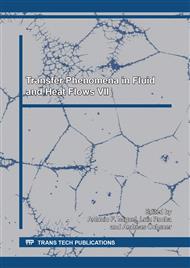[1]
H. C. Lau, M. Yu, and Q. P. Nguyen, Nanotechnology for oilfield applications: Challenges and impact,, J. Pet. Sci. Eng., vol. 157, p.1160–1169, (2017).
Google Scholar
[2]
C. Matteo, P. Candido, R. Vera, and V. Francesca, Current and Future Nanotech Applications in the Oil Industry Department of Materials , Science and Chemical Engineering , Department of DIATI , Petroleum Engineering Group , Engineering Faculty , Politecnico di Torino ,, vol. 9, no. 6, p.784–793, (2012).
Google Scholar
[3]
G. Cheraghian and L. Hendraningrat, A review on applications of nanotechnology in the enhanced oil recovery part B: effects of nanoparticles on flooding,, Int. Nano Lett., no. JANUARY, (2015).
DOI: 10.1007/s40089-015-0170-7
Google Scholar
[4]
S. D. Nair, Q. Wu, M. Cowan, and E. Van Oort, Cement Displacement and Pressure Control Using Magneto-Rheological,, (2015).
DOI: 10.2118/173124-ms
Google Scholar
[5]
L. Long, X. Xianguang, S. Jinsheng, Y. Xubo, L. Yingmin, and C. Drilling, Vital Role of Nanomaterials in Drilling Fluid and Reservoir Protection Applications,, SPE Int., (2012).
DOI: 10.2118/160940-ms
Google Scholar
[6]
F. Qiu, The Potential Applications in Heavy Oil EOR With the Nanoparticle and Surfactant Stabilized Solvent-Based Emulsion,, in The Canadian Unconventional Resources & International Petroleum Conference, 2010, p.1–12.
DOI: 10.2118/134613-ms
Google Scholar
[7]
S. Genc and B. Derin, Synthesis and rheology of ferrofluids: A review,, Curr. Opin. Chem. Eng., vol. 3, p.118–124, (2014).
Google Scholar
[8]
S. Odenbach and S. Thurm, Magnetoviscous Effects in Ferrofluids,, in Ferrofluids: Magnetically Controllable Fluids and Their Applications, Springer-VerlagBerlin Heidelberg, 2002, p.185–201.
DOI: 10.1007/3-540-45646-5_10
Google Scholar
[9]
G. Lei, L. Li, and H. A. Nasr-el-din, New Gel Aggregates To Improve Sweep Efficiency During Waterflooding,, SPE Reserv. Eval. Eng., vol. 14, no. 1, p.120–128, (2011).
DOI: 10.2118/129960-pa
Google Scholar
[10]
Z. Vryzas, V. C. Kelessidis, M. B. J. Bowman, and L. Nalbantian, Smart Magnetic Drilling Fluid With In-Situ Rheological Controllability Using,, in SPE Middle East Oil & Gas Show and Conference, 2017, no. January.
DOI: 10.2118/183906-ms
Google Scholar
[11]
A. A. Velásquez and J. P. Urquijo, Influence of Co2+ on the structural and magnetic properties of substituted magnetites obtained by the coprecipitation method,, Hyperfine Interact., vol. 232, no. 1–3, p.97–110, (2015).
DOI: 10.1007/s10751-015-1122-3
Google Scholar
[12]
M. H. Habibi and H. J. Parhizkar, FTIR and UV-vis diffuse reflectance spectroscopy studies of the wet chemical (WC) route synthesized nano-structure CoFe2O4 from CoCl2 and FeCl3,, Spectrochim. Acta - Part A Mol. Biomol. Spectrosc., vol. 127, p.102–106, (2014).
DOI: 10.1016/j.saa.2014.02.090
Google Scholar
[13]
D. I Santiago-Quinones, C. Rinaldi, and K. Raj, A comparison of the magnetorheology of two ferrofluids with different magnetic field-dependent chaining behavior,, Rheol. Acta, vol. 52, p.719–726, (2013).
DOI: 10.1007/s00397-013-0715-5
Google Scholar
[14]
H. Soleimani, N. R. Ahmad Latiff, H. M. Zaid, N. Yahya, A. R. Sadrolhosseini, and M. Adil, Influence of cobalt substitution on the structural and magnetic properties of cobalt substituted magnetite,, AIP Conf. Proc., vol. 1787, p.1–7, (2016).
DOI: 10.1063/1.4968106
Google Scholar
[15]
J. M. Linke and S. Odenbach, Anisotropy of the magnetoviscous effect in a cobalt ferro fluid with strong interparticle interaction,, J. Magn. Magn. Mater., vol. 396, p.85–90, (2015).
DOI: 10.1016/j.jmmm.2015.08.029
Google Scholar
[16]
L. Wang, Y. Wang, X. Yan, X. Wang, and B. Feng, Investigation on viscosity of Fe3O4 nanofluid under magnetic field,, Int. Commun. Heat Mass Transf., vol. 72, p.23–28, (2016).
DOI: 10.1016/j.icheatmasstransfer.2016.01.013
Google Scholar
[17]
M. E. Khosroshahi and L. Ghazanfari, Preparation and rheological studies of uncoated and PVA-coated magnetite nanofluid,, J. Magn. Magn. Mater., vol. 324, no. 24, p.4143–4146, (2012).
DOI: 10.1016/j.jmmm.2012.07.025
Google Scholar
[18]
G. Paul, P. Kumar Das, and I. Manna, Synthesis, characterization and studies on magneto-viscous properties of magnetite dispersed water based nanofluids,, J. Magn. Magn. Mater., vol. 404, p.29–39, (2016).
DOI: 10.1016/j.jmmm.2015.11.085
Google Scholar
[19]
M. Zallaghi, R. Kharrat, and A. Hashemi, Improving the microscopic sweep efficiency of water flooding using silica nanoparticles,, J. Pet. Explor. Prod. Technol., (2017).
DOI: 10.1007/s13202-017-0347-x
Google Scholar
[20]
D. Tiab and E. C. Donaldson, Chapter 3 - Porosity and Permeability,, in Petrophysics, 4th ed., 2012, p.85–219.
DOI: 10.1016/b978-0-12-383848-3.00003-7
Google Scholar
[21]
A. I. El-diasty, A. M. Aly, T. P. S. Technical, and P. Services, Understanding the Mechanism of Nanoparticles Applications in Enhanced Applications of Nanoparticles in EOR,, vol. 0, p.1–19, (2015).
Google Scholar
[22]
M. T. López-López, A. Gómez-Ramírez, L. Rodríguez-Arco, J. D. G. Durán, L. Iskakova, and A. Zubarev, Colloids on the frontier of ferrofluids. Rheological properties.,, Langmuir, vol. 28, no. 15, p.6232–6245, Apr. (2012).
DOI: 10.1021/la204112w
Google Scholar
[23]
J. Buciak, G. F. Sancet, and L. Del Pozo, Polymer-Flooding-Pilot Learning Curve : Five-Plus Years' Experience To Reduce Cost per Incremental Barrel of Oil,, SPE Reserv. Eval. Eng., no. October 2013, p.11–19, (2015).
DOI: 10.2118/166255-pa
Google Scholar


